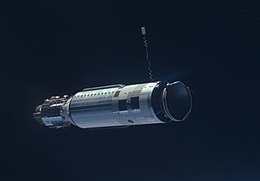Augmented Target Docking Adapter
 |
|
| Manufacturer | |
|---|---|
| Country of origin | United States |
| Operator | NASA |
| Applications | |
| Specifications | |
| Launch mass | 18,030–18,100 pounds (8,180–8,210 kg) |
| Dry mass | 4,012–4,085 pounds (1,820–1,853 kg) |
| Dimensions |
|
| Power | Batteries |
| Equipment |
|
| Production | |
| Status | Retired |
| Built | 7 |
| Launched | 7 |
| Failed | 3 |
| First launch | October 25, 1965 |
| Last launch | November 11, 1966 |
| Related spacecraft | |
| Derived from | Agena-D |
| Derivatives | Augmented Target Docking Adapter |
| Flown with | Gemini |
The Agena Target Vehicle (ATV), also known as Gemini-Agena Target Vehicle (GATV) was an unmanned spacecraft used by NASA during its Gemini program to develop and practice orbital space rendezvous and docking techniques, and to perform large orbital changes, in preparation for the Apollo program lunar missions. The spacecraft was based on Lockheed Aircraft's Agena-D upper stage rocket, fitted with a docking target manufactured by McDonnell Aircraft. The combined spacecraft was a 26-foot (7.92 m)-long cylinder with a diameter of 5 feet (1.52 m), placed into low Earth orbit with the Atlas-Agena launch vehicle. It carried approximately 14,021 to 14,054 pounds (6,360 to 6,375 kg) of propellant and gas at launch, and had a gross mass at orbital insertion of 7,117 to 7,271 pounds (3,228 to 3,298 kg).
The ATV for Gemini 6 failed on launch on October 25, 1965, which led NASA to develop the Augmented Target Docking Adapter (ATDA) as a backup, a smaller spacecraft consisting of the docking target fitted with an attitude control propulsion system, but lacking the Agena orbital change rocket. The ATDA was used once on Gemini 9A after a second ATV launch failure on May 17, 1966, but failed as a docking target because its launch shroud failed to separate.
Each ATV consisted of an Agena-D derivative upper rocket stage built by Lockheed Aircraft and a docking adapter built by McDonnell Aircraft. The Agena was launched from Cape Kennedy's Launch Complex 14 on top of an Atlas booster built by the Convair division of General Dynamics. The Agena first burn would occur shortly after shroud jettison and separation from the Atlas over the Atlantic Ocean. Over Ascension Island, a second burn would place the Agena into a low circular orbit.
...
Wikipedia
